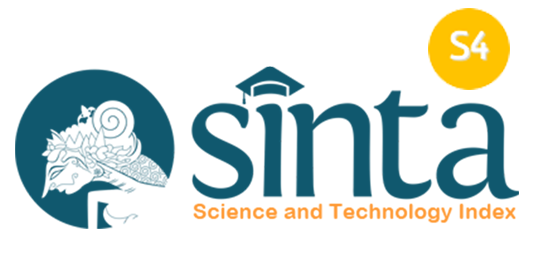THE CHALLENGE OF APPLYING COMPETENCY-BASED TEACHING AND STUDENT-CENTERED INSTRUCTIONS IN A HIGHER EDUCATION LEVEL
Abstract
Full Text:
PDFReferences
Allwright, D., et al. (1991). Focus on the Language Classroom: An Introduction to Classroom Research for Language Teachers. Cambridge: Cambridge University Press.
Bergeson, T., et al. (1998). Research into Practice: An Overview of Reading Research for Washington State. Washington: EDRS.
Berry, B. (2008). What It Means to Be a “Highly Qualified Teacher”. [Online]. Available at: http://www.umatilla.k12.or.us/NCLB/ definingHQ%2 0teachers. Pdf.[ 10th September, 2009).
Brooks, J.G. & Brooks, M.G. (1999). In Search of Understanding: The Case for Constructivist Classrooms. Alexandria: Association for Supervision and Curriculum Development.
Brown, H. D. (1994a). Principles of Language Learning and Teaching. Englewood Cliffs: Prentice Hall Regents.
Brown, H. D. (1994b). Teaching by Principles: An Interactive Approach to Language Pedagogy. New Jersey: Prentice Hall Regents
Brown, K. (2007). Strengthening the Home-school Literacy Connection. Thesis in Bowling Green State University: Unpublished.
Chiappetta, E.L. et al. (1998). Science Instruction in the Middle and Secondary Schools. Upper Saddle River, NJ: Prentice Hall.
Cuban, L. (1990). “Reforming again, again, and again”. Educational Researcher, 19 (1), 3-13.
Cummins, J. (1984). “Wanted: A Theoretical framework for Relating Language Proficiency to Academic Achievement among Bilingual Students” In C. Rivera (Ed)”. Language Proficiency and Academic Achievement (pp. 83-102). Clevedon, UK: Multilingual Matters.
Darling-Hammond, L. (2006). “Highly Qualified Teachers for All”. Educational Leadership/ Nov, 2006.
DeFord, D.E. (1986). Literacy: Reading, Writing and Other Essentials. Language Arts, 58 (6), 652-658.
Depdiknas. (2007). Undang-Undang Guru dan Dosen. Jakarta: Sinar Grafika.
Ellis, R. (1987b). Second Language Acquisition in Context. Great Britain: Prentice Hall.
Farland, D.N.N.C. (1984). Management: Theory and Practice. Tokyo: Mc. Graw-Hill Kogahusa.
Gruber, G. R. (2008). Gruber’s Essential Guide to Test Taking: Grade 3-5. Illionis: Source Books Inc.
Hendry, G.D. (1996). “Constructivism and Educational Practice”. Australian Journal of Education, 40 (1), 19-45.
Hession, J. (2006). Joaquin Miller Elementary. Burbank Unified School District.
Lipson, M. Y & Wixson, K.K. (2003). Assessment & Instruction of Reading and Writing Difficulty. USA: Pearson Education, Inc.
Llewellyn, D. (2002). Inquiry within: Implementing Inquiry-based Science Standards. Thousand Oaks, CA: Corwin Press.
Morrow, L. M., et al. (Eds). (2009). Handbook of Research on Literacy and Diversity. USA: Guilford Press.
Musthafa, B. (2002). “English Teaching in Indonesia: Status, Issue and Challenges”. ESL Magazine. January/February 2002.
Pressley, M., et.al. (2001). “Strategies that Improve Children’s Memory and Comprehension of Text”. The Elementary School Journal. 90 (1), 3-32.
Richards, J.C. (1998). Classroom-Based Evaluation in Second Language Education. Cambridge: Cambridge Language Education.
Richards, J. C. (2001). Curriculum Development in Language Teaching. Cambridge: Cambridge University Press.
Research Project. (2006). Teacher Recruitment and Retention.[Online]. Available at: http:/www.ark.leg.state.ar.us. [August 22nd , 2006].
Santrock, J. W. & Arends, R. I. (2001). Educational Psychology. New York: McGraw-Hill.
Stern, H.H. (1983). Fundamental Concepts of Language Teaching. Melbourne: Oxford University Press.
Turner, J. D. and Kim, Y. (2005). “Learning about Building Literacy Communities in Multicultural and Multilingual Classrooms from Effective Elementary Teachers”. Literacy Teaching and Learning 10 (1). 21-41.
DOI: https://doi.org/10.29313/performa.v0i2.3032
Refbacks
- There are currently no refbacks.
Copyright (c) 2014 Jurnal Manajemen dan Bisnis: Performa
Jurnal manajemen dan bisnis (Performa) diindeks oleh:
Alamat Redaksi:
Jl. Tamansari 1, Bandung 40116, Jawa Barat, (022) 4203368 pes. 210, (022) 4264064. jmb.performa@gmail.com / jmb.performa@unisba.ac.id

This work is licensed under a Creative Commons Attribution-NonCommercial-ShareAlike 4.0 International License. ISSN 1829-8680 | E-ISSN 2599-0039

_(2).jpg)







